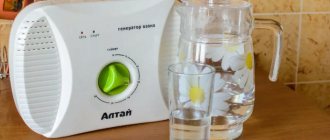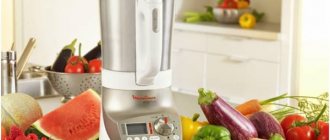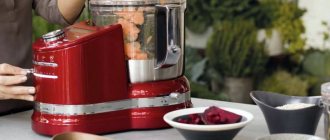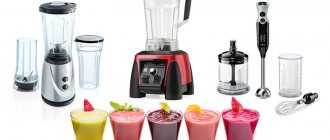A woman has many helpers in the kitchen. And no matter how wryly the men grin, these kitchen workers still make difficult work much easier, because a modern woman has to keep up with everything around the house, take care of the children, and not lose herself in the daily bustle of all these things. Some of these helpers are a blender and a food processor. Which device should you choose? Is one enough, or will I have to buy different ones? Let's look at the features of each and find out why one and the other device is needed.
general characteristics
Equipment with various options simplifies kitchen activities related to the following purposes:
- shredder;
- kneading dough;
- whipping;
- cutting products.
To understand which device is worth purchasing, you should understand the characteristics of the equipment.
Blender or food processor?
Blenders
The devices are presented in three types:
- submersible;
- stationary;
- models equipped with various options.
The first option is equipped with a plastic holder, which means the owner can hold it with one hand. The advantage is versatility, as it makes it possible to work with any containers.
The device with a stationary container has a powerful motor and blades for cutting hard products.
Only liquefiers equipped with advanced capabilities and extensive configurations can completely replace an electromechanical apparatus. Of course, they belong to the premium line, but they justify the investment after some time. Thus, the minimum motor power is 600 W, which makes it easy to cope with the requirements.
Stationary blender
Immersion blender
Food processors
Universal devices are used by housewives to perform a wide range of tasks. The equipment has a drive, thanks to which the user can easily cope with kneading dough and preparing creams. Moreover, they are able to prepare minced meat or fish and chop vegetables.
Additional characteristics:
- Convenient care - all components are removable, which makes them easy to wash and dry.
- Possibility of preparing large and small portions.
- Mechanical or electronic adjustment (depending on model).
Food processor
Important! It is noteworthy that plastic elements have low resistance to high temperatures. Therefore, over time they turn yellow and emit an unpleasant odor.
Blender or food processor - what's the difference?
Usage:
- A food processor works well with solid foods, while a blender works better with liquid foods.
- Blenders are also known as juicers or liquefiers. They are used for mixing soft foods and liquids. These are good helpers in preparing various fruit juices with pulp, pureed soups, and perfectly mixed sauces.
- also use a blender to mix different drinks, from milkshakes to alcoholic cocktails.
- The main job of a food processor is set to shredding, slicing, slicing, grating or mixing hard or soft foods.
- A food processor is more versatile than a blender. The capacity of the food processor is wider.
- A food processor also performs many other tasks. For example, you can use it to make pureed soup, but it will not be as tender as if you prepare it using a blender.
- But when you try to grate something with a blender , you will only get a watery and practically unprocessable mass.
- On the other hand, if you make puree using a food processor , there will be no liquid in it.
Complexity of technology:
- A food processor is a complex multi-purpose device that includes a huge number of attachments, knives, additional bowls, graters and other accessories.
- But the blender is characterized by a significant simplicity of design and can only be equipped with two or three additional attachments that turn it, for example, into a chopper. Hence the obvious difference - a food processor is more complex in design.
Size:
- There is also a purely visual difference : a food processor is relatively large and needs a lot of space, while a blender can often fit in a very small corner or in a drawer because it is more compact in size.
Price:
- In terms of cost, a food processor is far ahead of a blender. And the advance here is directly dependent on the complexity of the designs, the number of different gadgets and the device that expands and complements the functionality. And a blender is cheaper because it’s simpler.
Pros and cons of a blender
Stationary devices with modern equipment are practically not inferior to electromechanical units in their functionality.
Advantages of the devices:
- Small sizes. The components of even large models do not take up much space, and some representatives have the ability to be fixed on the wall.
- Universal application. For young parents, immersion devices are a quality aid in preparing baby food. The technique is also designed to create dishes such as:
- cream soup;
- minced meat or fish;
- potato, fruit puree;
- cream;
- Dessert;
- as well as cutting vegetables.
- Some devices allow you to use them while preparing food. However, manufacturers advise bringing food to room temperature.
- Almost every part can be washed in the dishwasher.
Significant disadvantages:
- limited options;
- cannot withstand intense loads;
- the submersible type is inconvenient for long-term use, because sometimes housewives get tired of holding the equipment;
- work with a small list of products.
Remember
- Prepare complex dishes. If you have a lot of space in the kitchen, you have to cook a lot, and the dishes are often complex and require specific preparation, choose a food processor.
- Cook sometimes or simple dishes. If the kitchen is small, the budget for purchasing equipment is limited, you cook few, infrequently and simple dishes, then your choice is a blender, stationary or immersion.
- Pay attention to the price . If the high cost does not scare you, this is another argument in favor of the combine.
Pros and cons of the combine
The bonuses of this type of equipment include:
- preparing solid foods - nuts, cinnamon, dried fruits, etc.;
- an alternative to purchasing appliances such as a meat grinder, mixer, juicer, etc.;
- the ability to prepare smoothies, cocktails, dough of any consistency;
- high-quality processing of vegetables during canning.
Negative sides:
- high purchasing costs;
- take up a lot of kitchen space.
Shredder Application
A chopper is a cross between a food processor and a regular manual chopping machine. As a rule, this device consists of a bowl with a handle on top.
Choppers allow you to finely chop both whole foods and large pieces.
Chopped food can be added to salad or processed in some other way. Depending on the chopping method, these devices are divided into choppers and multi-cutters.
The main working element of a chopper is a rotating blade-impeller . Such a device is even capable of whipping some liquid products (sauces, pancake dough, cream). The quality of cutting depends on the operating time of the knives, as well as on their location.
When the blades are positioned low, you will get a puree-like mixture, and when the blades are placed high, you will get a fairly coarse cut. As a rule, the height of the knives can be adjusted.
It is worth noting that the chopper does not give a uniform consistency: the finished mixture will consist of both small and larger particles.
A homogeneous composition can only be achieved by grinding the products to a puree state.
Multi-cutters have rotating disks on which notches of different sizes and shapes are applied..
Such devices can chop and cut food into slices, and the particles will always have the same size.
You will not be able to beat or stir liquid products using multi-cutters. Typically, multi-cutters do not have their own bowl, so they are used in their own container, just like a hand blender.
pros
- excellent crushing of hard products (meat, nuts, ice);
- obtaining uniform, well-cut pieces;
- small dimensions of the device.
Minuses
- little functionality;
- heating during prolonged use.
A chopper is in many ways similar to a blender, both in functionality and appearance. It is worth noting that the bowl for chopping food in a chopper is always located at the bottom, while in a stationary blender it is installed at the top .
Main Differences
Blender or food processor, what to choose? It is problematic to choose just one type, since the technology is similar in functionality. Therefore, you should familiarize yourself with the fundamental differences.
Equipment complexity
An electromechanical device is a complex multi-purpose device that includes several types of attachments, additional containers, graters and other accessories. The device is equipped with an electronic or mechanical control type. In view of this, the user should read the operating instructions before operation.
The liquefier has a simple design and is often equipped with 2-3 attachments designed for chopping products and kneading dough.
Interesting! An electric stirrer is used when working with liquid substances, and an electromechanical device is capable of crushing, shredding or grating even very hard vegetables.
Size
Visually, the equipment varies in size. Thus, a kitchen electromechanical assistant takes up a lot of space in the kitchen. Whereas the blender is placed in a small box or compartment, i.e. it has compact dimensions.
Price ratio
Electromechanical equipment is an order of magnitude higher in price than electric mixers. This is due to design features and equipment - nozzles, options, type of control, brand.
Additional Differences
Comparison table of the differences between food processors and blenders:
| Parameter | Blender | Harvester |
| Compactness | Low due to large size | Satisfactory performance - equivalent for submersible and stationary types |
| Additional features | High, because it is equipped with more than 10 options | Average rating for all types of devices |
| Food used | Almost any | Often only soft |
| Price | Overpriced | Economical option |
| Volume | The devices are equipped with different containers | Small compared to an electromechanical device. However, they are universal, because they work with any containers. |
| Difficulty of operation | Requires skill | Simple |
| Ease of use | A lot of parts need to be cleaned | Cleaning takes 5-7 minutes |
| Practicality | Insignificant, as it is used only for large portions | Daily use |
Compare device performance
To choose one of the devices, you need to compare their characteristics.
Photo: stozabot.com Characteristics: blender or food processor:
| Immersion and stationary blenders | ||
| Dimensions | Bulky - requires a lot of space for installation and storage |
|
| Number of functions | Can replace more than 10 different kitchen appliances | Both types replace 5–8 kitchen appliances |
| Food Processing Ability | Can handle all types of products - both hard and soft | Both machines are designed for processing soft products, but can also process some types of hard components |
| Price | High | Depends on the blender model, but compared to a food processor - low |
| Capacity | Significant—equipped with bowls of different volumes, but capacious |
|
| Difficulty of application | The unit is difficult to use | Both devices are easy to use |
| Comfort of service | Unsatisfactory, has to be disassembled for cleaning | Both devices are easy to clean |
| Practicality | Satisfactory, the appliance is used only for preparing large volumes of food and drinks | Both devices are practical and can be used for cooking both small and large volumes of food. |
If you are undecided whether you prefer a food processor with a blender and mixer, or individual devices, ask yourself the following questions:
- Is there space in the kitchen to install large appliances?
- How often will you need to use the combine?
- Which products by degree of hardness most often need to be processed.
- Will buying a food processor cause significant damage to your budget?
- What volumes of food have to be prepared.
- Which options (mixing, chopping, beating, chopping, etc.) are most needed?
The answers will help you choose a blender and food processor.
If the room is spacious, buy a combine, it can perform more functions. Photo: tehno-rating.ru
Ease of use
When choosing household appliances, housewives note that the main criterion is comfortable use and speed in preparing dishes.
Exploitation
Electromechanical units have high-quality performance when processing solid products.
Area of use of the device:
- shredding;
- cutting;
- cutting into thin layers;
- grater;
- mixing.
In addition, the device is versatile, spacious and with its help the housewife can prepare a delicate puree soup. However, when creating mashed potatoes, the liquid level is low, requiring the addition of milk or water.
In turn, a stationary blender copes well with liquid substances. The technique also has secondary names - juicer, liquefier, mixer. Used for kneading soft food and liquid substances. They have proven themselves well in creating fruit juices and sauces. Moreover, using the device, users create a variety of drinks - milkshakes, fruit cocktails, alcoholic drinks. However, it will not be possible to grate food through it, because the water level will be too high.
Process of preparation with an immersion blender
Advice! Handheld types of blenders are available in the market with wireless connectivity. This find is relevant for summer residents and families who often go on a picnic. However, you should remember that their functionality is limited.
Varied menu
For occasional preparation of small portions of food, a small immersion mixer is sufficient. Of course, you can choose a large and powerful stationary blender that allows you to process vegetables, meat, and fruits for a family of 3-4 people. However, there are restrictions on the frequency and volume of servings. This choice is also made by those who like to create cocktails and fruit smoothies. At the same time, the liquefier does not take up much space in the kitchen when compared with a juicer or meat grinder.
With a food processor, housewives can prepare a wide range of dishes - meat purees, soups, vegetable and fish dishes, as well as pastry desserts. By purchasing electromechanical equipment, the user relieves himself of the burden of chopping, chopping and cutting food, which is convenient during the winter preparation season.
Number of family members
The main criterion in the question of how a blender differs from a food processor is the volume of portions. Thus, a capacious electromechanical device reveals its full potential if it is constantly loaded to the maximum level. Thus, the equipment is suitable for large, numerous families or those who often have relatives and guests. However, it should be remembered that the equipment takes up a lot of space in storage and use.
The hand mixer is suitable for a family of 1-2 members or young parents.
Food Processor Features
Know the differences between a combine harvester
A food processor is a multifunctional kitchen appliance that can replace almost all food processing equipment.
Photo: smadshop.md The combine consists of three parts:
- Housing with built-in electric drive.
- A set of attachments (whisk, meat grinder, shredder, knives, etc.) connected to the base from above.
- Several bowls in which various products are processed.
Depending on the attachment, the combine can:
| 1. Peel vegetables and fruits | |
| 2. Cut, grind and shred food | |
| 3. Knead the dough | |
| 4. Extract juice from greens, fruits and vegetables | |
| 5. Whip cream, cocktails, purees and creams | |
| 6. Twist the minced meat | |
| 7. Grind coffee beans, ice and frozen foods |
Accordingly, the food processor combines the functions of several kitchen appliances connected to a single housing:
- mixer;
- meat grinders;
- shredders;
- shaker;
- blender;
- coffee grinders;
- ice crusher;
- juicers, etc.
The food processor is bulky and requires a lot of free space in the kitchen.
Photo: notus.com.ua Therefore, the device is characterized by:
- big sizes;
- significant power;
- high price.
But this does not mean that a food processor with a blender and a juicer is worse/better than separate units.
Conclusion:
What is the difference between a blender and a food processor - it processes relatively soft products. The blender grinds the puree, mixes and beats the ingredients of the dish. Not intended for cutting and shredding.
Models with a powerful drive and attachment are capable of crushing solid components, twisting minced meat, and crushing ice. But a blender is practically not used for cutting and grating food.
Adviсe
- The diversity of the product line on the market allows customers to select models from kitchen electromechanical appliances, as well as liquefiers, based on technical characteristics. However, there is no universal solution. For example, a food processor is equipped with the option of making cocktails, but it will not do it better than a blender. However, the latter will not chop the vegetables into cubes, as the former will.
- Harvesters are more expensive.
- If we evaluate devices by difficulty of use, then the mixer is easier to use.
- Washing and cleaning the liquefier is also faster and easier.
- On the practical side, the electromechanical assistant is used occasionally, so it cannot be found in every home. Before purchasing, experts recommend identifying which dishes are most often prepared - purees and cocktails require an assistant in the form of a blender, and cutting vegetables and kneading dough requires a food processor.
- Gourmets often choose a food processor because they love to eat delicious food obtained by beating, thoroughly mixing, as well as squeezing and grating various products. It is noteworthy that washing dishes is a common task, and the space shortage is insignificant.
- Surveys of housewives have shown that most women use a hand mixer daily. However, in the absence of electromechanical equipment, most people think about purchasing it, especially during the season of canning fruits and vegetables.
- If you have an electric meat grinder or mixer at home, it is not advisable to buy a food processor with such functions. Therefore, a simple liquefier with the option of twisting meat and the necessary equipment is an ideal option.
Watch a video about the blender's abilities
What is better for a housewife?
To summarize all that has been said, the following conclusion follows: both a blender and a food processor will become indispensable in the kitchen and will help in performing many tasks. The main differences between these devices are functionality and design. A multi-purpose food processor will replace more than one device, but it will cope worse with preparing puree soup or liquid cocktail. When making a choice between one and the other, it is first of all important to determine which tasks require completion.
Using a juicer in the kitchen
Juicers are a completely separate class of devices that differ widely in functionality and purpose. However, in any case, they all serve to perform one task - squeezing juice.
Types of juicers:
- For citrus fruits . Allows you to obtain juice only from citrus fruits, has low power and compact dimensions.
- Auger . This device works on the principle of a press - the product is placed under a screw, which moves and forcefully squeezes the juice out of the product. This type has the highest productivity, as it can squeeze maximum juice out of the pulp.
- Grid or centrifugal . The most common type, the working element of which is rotating knives placed in a container with mesh walls. During operation, the product is crushed and rubbed through a mesh, due to which the juice is released, and the unnecessary pulp is automatically removed into a special container. The performance of such a juicer depends on its power; the most powerful devices can process hard fruits and vegetables.
The advantages and disadvantages of juicers depend on their type and power. It’s worth taking a closer look at the differences between a juicer and a blender:
pros
- A juicer produces pure, pulp-free juice, while a blender produces mixed juice that is more like a liquid puree.
- The juicer removes the used pulp into a separate container, while the blender leaves it along with the juice.
- The operating time of juicers ranges from 5 to 15 minutes. Expensive blenders are able to work until the desired consistency of the product is achieved.
- The juicer can even handle hard vegetables and fruits. A blender will simply chop them up, or, in extreme cases, turn them into mush.
- A juicer is used only for making juice, while a blender is suitable for making purees or a variety of fruit smoothies.
Minuses
- no significant deficiencies were identified.
In general, the choice again depends on the needs that arise in the kitchen . A blender allows you to carry out a variety of operations, but you cannot get juice with it. If you need freshly squeezed juice, then you cannot do without a high-quality juicer.
Compact assistants
Blenders have long been recognized as efficient small-sized household appliances. They come in 2 types:
- submersible, consisting of an elongated body with a motor inside, to which various nozzles can be attached;
- stationary, also with a motor inside, but installed on a table.
The blade attachment is used for mixing or crushing foods. The whisk whisks food, resulting in juices, mousses or purees.
The blade attachment is used for mixing or crushing foods. The whisk whisks food, resulting in juices, mousses or purees.
The submersible model is loved by housewives due to its compactness and decent functionality. The unit can, for example, be hung on the wall, which allows it to be used even in a small kitchen. And thanks to its mobility, the device can be used in different containers. To prevent food from splashing, do not fill the bowl to the brim.
The disadvantage of this option is that it must be held in an upright position and the button must be pressed constantly. In addition, the volume of products that can be processed is small. But the quality is excellent.
The stationary blender starts functioning after pressing the button without having to hold it. Therefore, all you need to do is pour the products to be processed into the jug. Some models, in addition to the above dishes, allow you to make crushed ice. But this is only possible if such a function is provided by the device.
The stationary blender starts functioning after pressing the button without having to hold it.
The advantage of the model is that the owner does not have to keep the button pressed all the time. At the same time, it is designed for large portions. Therefore, this blender is not suitable for every family.











